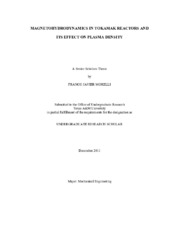| dc.description.abstract | The world’s energy consumption is at a crossroads. While petroleum coffers continuously yield enough petroleum to meet the current state of energy consumption, increases in energy consumption and advancements in technology bear significant weight on our ability to maintain current standards. Looking ahead, plasma fusion is a means of yielding vast amounts of clean, renewable and virtually limitless amounts of energy. With many advancements taking place since the 1950’s, the current Tokamak reactor claims to be able to produce more energy than it consumes, realizing a dream over 60 years in the making. Many characteristics, including plasma density, have to be tuned to maintain optimal conditions. By using finite element method embodied in COMSOL and first principles, one attempts to show how the plasma density evolves through a Tokomak’s modes of operation and to quantify the density against a known standard. | en |


